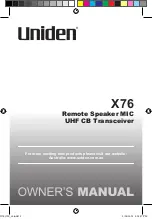
70
58-603 Pulsar
®
Model R86 Radar Transmitter
Widening an existing echo
ADD this as addition to Amplitude so there is one???
Widening an existing echo in the custom rejection echo curve consists of the user identifying the
desired echo and defining the width changes to be made to that echo. The widening process creates
an echo shape in which the left and right side slopes of the original echo remain the same, although
separated, and that has a flat top at the peak amplitude of the original echo.
1. The user starts the Customize Rejection Curve method, then selects “Modify existing Echo” as the
modification option.
2. Upon presentation of the Rejection echo list, along with a display of the present level, select the
desired echo to be modified. (The distance to the echo must be smaller than the distance to the level
echo).
3. The user is presented with the existing locations for where the echo crosses the base threshold.
4. The user enters the new left and right locations for the base crossing threshold points.
Narrowing an existing echo
(???Alan checking if we can actually do this)
Narrowing an existing echo in the custom rejection echo curve consists of the user identifying the
desired echo and defining the width changes to be made to that echo.
NOTE: Narrowing an echo can only be performed if the echo has already been widened.
1. The user selects “Modify existing Echo??????????” as the modification option.
2. Upon presentation of the Rejection echo list, along with a display of the present level, the user selects
the desired echo to be modified. The distance to the echo must be smaller than the distance to the
level echo.
3. The user is presented with the existing locations for where the echo crosses the base threshold.
4. The user enters the new left and right locations for the base crossing threshold points.
Reset Custom (rejection) curve
Use Reset Custom curve to erase what has been done to the Custom Rejection to start over.
4.x Tank Profile
Introduction
Non-Contact radar transmitters are typically configured and commissioned with a static liquid level.
Ideally, the installer will generate some level change after commissioning to verify proper operation,
but rarely can one witness a complete fill and empty cycle of the vessel. Therefore, the transmitter
configuration may not initially be optimized for the entire range of operation.
Although previous versions of Magnetrol transmitters contain troubleshooting options for recording
and saving diagnostic information such as Data Log, Event History, and Echo History, none contains
a way for the device to automatically capture pertinent information
for an entire fill and empty cycle
.
As this complete cycle could take hours, days or even weeks to complete, having this information will
confirm proper operation for a given configuration or can provide precious information about the
transmitter performance at troublesome levels in the tank.
The information is stored in the transmitter, retrieved at a later time and evaluated by a qualified indi-
vidual who will decide the next steps to take.











































